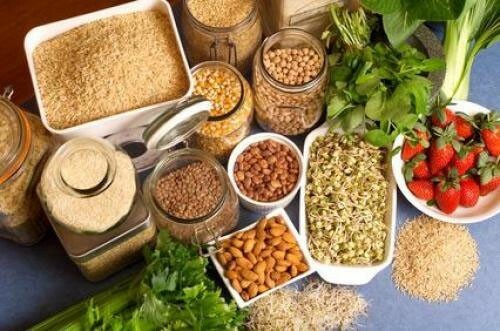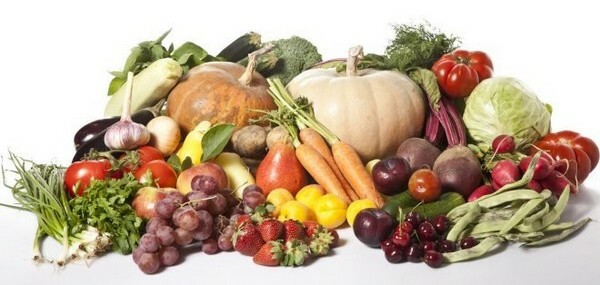- The concept of fiber, types and its capabilities
- Fiber: its health benefits and harm
- How to make up a deficiency of fiber? Fibers should be in the diet every day.
. If you have never thought about proper nutrition, did not attach importance to proteins, fats, carbohydrates, and you do not know how our body works,perhaps you do not know anything about fiber. We hope that such a minority, but even those who have knowledge, often can not accurately give a definition, say why and how to use the product. And for those, and for others this article will be very useful, here you will find out what fiber is for and everything that concerns this issue. This is very important, because health must always be protected, and not to fight the consequences of their own thoughtless actions, when something inside has failed.
The concept of fiber, species and its capabilities
Definition of
The benefits of plant foods are constantly being told all around. Most of us understand that, they say, vegetables, fruits are necessary, they are useful. And that's all. Most often a person simply responds that these foods give us vitamins. There are also those who believe that there is plant food, and not an animal is needed for ethical reasons, but this is very superficial knowledge. Vegetable food contains many necessary components for us, and, of course, it is a source of fiber. This part of plants and fruits that is not digested by our body is also called a complex carbohydrate.

Someone now can ask the question, how can something useful that our body can not cope with. The fact is that it is difficult for the digestive tract when it can not digest our surplus food, because they stay inside in the form of fat, toxins, slags and other unnecessary substances.
Fiber is a coarse fiber that, although it can not be digested, is excreted well, and at the same time pulls all the harmful components in the body that poison it, and this is not an exaggeration.
For your reference! You can often hear the question, vegetables - is it carbohydrates or fiber? The latter is an unsplit carbohydrate, which is a part of vegetables.
Fiber is not split because in our stomach, and, more precisely, the juice, there is no enzyme that could act on the fiber. It is found only in a small number of plants of lower origin and some microorganisms. The latter live partly in the human intestine, and there a small part of the fiber can be split, but in general the fibers remain intact.
Such different fiber
Fiber can be of two kinds - it is a soluble and insoluble fiber. In the first case, the substances that appear in our digestive tract are transformed into jelly or a kind of glue gel or otherwise into resin. These resins help the food inside last longer to be fresh due to the enveloping effect. The processes of decay do not occur, the substances are absorbed as much as possible. This has a beneficial effect on blood sugar levels and lowers cholesterol, which helps and prevents a number of dangerous diseases. This is separately described in the section on the benefits of fiber.
Soluble fiber is:
- resinous substances. They are able to preserve food, slow down the processing of carbohydrates into glucose, have a certain percentage of disinfection. Contained in large quantities in legumes, soybeans;
- pectin. This is a kind of polysaccharides. Helps maintain moisture in the body, clots of viscous gel cleans the intestines from toxins and toxins, pathogenic environment. Has the function of sorbent. Pectin is plentiful in cabbage, apples, cucumbers;
- inulin. It is a monosaccharide, which has fructose in the composition, due to which the taste of the substance is sweetish. Disintegrates in the body to glucose. Has a nutritional function, replaces sugar.
Rough insoluble fiber is lignin, cellulose, hemicellulose. These substances do not dissolve and are not digested. They are resistant to the action of enzymes, draw from the body all the dirt and food remnants. Substances act like a sponge that absorbs and removes everything, making the body clean, without stagnation, fermentation and rotting food inside. Again, all this protects a person from a number of serious diseases.
For information! How much fiber do you need per day? Sure, you already ask. And you need it to 35 grams. This is the norm, but you can exceed it to 50 grams, but do not overdo it, otherwise there may be unpleasant consequences.
Insoluble fiber is found in many herbal products, and they must be included in the daily diet. Most of this fiber in cereals, vegetables such as celery, carrots, beets. Also a lot in nuts, there are fibers and berries. Of course, all this is better to eat in a fresh, not thermally processed form.
That's interesting! Bread is made from wheat - everyone knows it, but most often we eat a product that is made from purified grains, namely as a whole, the raw grain is all good and the maximum of wheat fiber, so always choose products from whole grains.
How does coarse fiber work?
So, you will learn more, but a lot of interesting and, most importantly, important is yet to come. We advise you to read everything to the end, then you will take a fresh look at your life and nutrition, on which it depends, whether you are beautiful, young and energetic or sick and dull. Fiber is an indispensable product for cleansing the intestines. Many use a laxative, otherwise stagnant in the body, but whether to resort to chemical drugs, when everything is in plant foods. The possibilities of coarse fiber are colossal.
- When we eat foods that contain a lot of fiber, we have to chew a lot. And this is one of the rules of healthy eating. Saliva, which requires more, is excreted in the oral cavity, so most of the starch is split.
- Getting into the stomach, vegetable fiber fills its space, which provides a feeling of satiety. This is very important for those who are overweight. But also for incomplete people - this is important, because the need for snacks decreases.
- In the intestine, the fibers normalize the proper activity of the enzymes.
- Cellulose after consumption begins its way through the digestive tract, irritating its walls, more mucus and juice is released for digestion. This helps to quickly absorb and dissolve all the food that is in the stomach and intestines. Peristalsis improves, in the body does not happen stagnation.
- A number of microorganisms feed on, as was said before, a coarse fiber, and therefore, when the fiber enters the intestine, it provides food with a useful microflora. Otherwise, the pathogenic environment begins to develop more, adversely affecting human health.
- Fiber can be of various types, among which soluble pectin. It can help to lower the level of cholesterol, since it has a function to envelop it, after which a jelly-like mass forms, which does not allow the harmful substance to be absorbed. This is the prevention of a number of diseases, of which you also learn.
- Still soluble fiber reduces the need for insulin by almost 30%, which is understandably useful for people with a serious illness - diabetes mellitus.
It's important to know! All this benefit can not be underestimated, but one of the important properties of cellulose in foods is the ability to protect a person from oncology. Scientists have proved that the fibers are saved from carcinogens, which lead to cancer, and also do not allow them to linger in the intestines, thereby saving from oncology of the large intestine.
So, you already have an idea of what is curative fiber, how it works on our body, what kinds of fibers are there. Next, you will get acquainted with information about which diseases a plant product can become a preventative, and can also help during a disease.

Fiber: its health benefits and harm
How can fiber help our body?
- Helps to control the level of sugar in patients with diabetes mellitus. It also serves to prevent this disease.
- It is proven that the probability of cardiovascular disease is reduced by 40% in those who eat the right amount of fiber per day. Including the risk of stroke is reduced.
- Thanks to the feeling of satiety and the smooth functioning of the digestive tract, people with excess weight lose weight.
- Cleansing the body of the pathogenic environment, toxins and toxins, cellulose not only saves from illnesses, but also improves appearance. The skin is cleansed, it becomes elastic, radiant, taut.
- The pure organism is filled with energy, as the food is absorbed as much as possible, and the remnants do not linger.
- Cholesterol is lowered, the risk of developing polyps in the intestines is reduced by 40%.
- Fiber in bodybuilding is used to "dry" the body. Athletes arrange it for themselves before the competition, to remove the mass, and show only their muscles.
- Fibers help to get rid of constipation and prevent hemorrhoids.
- The risk of cancer is reduced.
- The problem of increased gas production is removed.
- The risk of gallstones is reduced.
- A person who eats enough fiber will not suffer from diseases of the stomach and intestines of all kinds.
- Accelerates metabolism.
- Reduces the risk of hypertension.
And you knew! After research, scientists found that nine out of ten people do not eat the right amount of food rich in fiber. That is, such a huge number of people can potentially become ill with a number of serious diseases.
Scientists have proved that if a person increases the consumption of coarse fibers to 35 grams per day and does it every day, then the weight begins to decrease and without much effort. But if you have a disease in the acute stage, the chronic form of certain organs, then a doctor's consultation is necessary. With regard to pregnant and lactating women, they can use fiber for food, but you need to monitor the reaction of your body and child. In any case, you can not dramatically increase consumption and, even more so, to digest more grams of fiber so as not to cause harm, but about it further.
Cellulose and its contraindications
Disadvantages of consumption can be if you exceed the dose or start eating a plant product for chronic gastrointestinal illnesses. Then there may come nausea, diarrhea, in the stomach will start to accumulate gases, there will be pain in the stomach or intestines. There is also a risk of dehydration, and an increase in acidity in the stomach. Breasts, when changing their ration, can sometimes be capricious, since the transition from liquid master milk to more complex food does not always go smoothly for them because of the still weak and undeveloped activity of the gastrointestinal tract.

How to make up the deficiency of fiber?
The next question that we will analyze is how to properly take fiber. So, to make up for the shortage of coarse fiber per day, you do not need to do something complicated. For example, you can eat:
- fruit - about 3-4 pieces, counting the percentage of fibers, because each product contains fiber in different amounts;
- vegetables - not less than 300 grams, the same rate is often set and dieticians;
- coarse whole grain bread - 4-5 pieces per day;
- 3-4 times a week dishes based on legumes;
- porridge, also well help to fill the deficit. But remember that the best cereal that was made from whole grains. Rice is better to replace with brown, since the raw product will be much more useful than white;
- dry fiber - take 2-3 tablespoons per glass of water. Be sure to drink water so that there is no deficit, especially when the body is cleaned regularly and well;
- nuts and dried fruits, bran. The rate of consumption is not difficult to calculate, since it is always possible to find the percentage of fiber content in a given product.
Tip! It is better to drink fiber not with water, but with a fermented milk product, so it's easier, and the whole mass is better distributed.
Buy dry fibers can be in many pharmacies at an affordable price. Also on sale is a product such as milk thistle. This healing plant is famous for its strength from time immemorial. It is especially useful for the liver and gastrointestinal tract. You can alternate the reception of different products. Usually, milk thistle fibers are taken three times a day before meals on a spoon, washed down with water. But manufacturers can specify another recipe, all this is on the package.
You now know what is dietary fiber, which can be both in products of vegetable origin, and in the finished form. You can buy it in pharmacies or specialty stores, you can also order the product through the Internet. But remember, it is better to consult a doctor with any new manipulations with your health. To pass analyzes and to pass or take place inspection will not prevent, even if you are assured of the health, but thus in hospital were not already very much for a long time.
For information Sometimes people ask a question, what concerns to a fat, whether it is possible to find it in meat, milk or eggs. No, in the animal origin of the products there are no plant coarse fibers and can not be.

Foods that we need in the diet, with fiber
Bran
One of the leaders in the content of coarse fibers that can be added to various dishes during cooking and eating them even for nothing. In 100 grams of bran can contain more than 40 grams of fiber. The indicators will vary depending on what kind of cereal the product was made from.
For example, fiber in oat bran is a well of use. They contain more than 15.5% of coarse fibers, and the wheat variety is also not inferior, as much as 40.3%.Bran in its capabilities and benefits are similar to fiber. It is worth noting that they are an important part of the diet from the Deccan.
Dried fruits and fruits, berry
About the benefits of those and others, even children know. Yes, and fruits, and dried fruits, and berries - a source of vitamins and nutrients, and fiber is a lot. By alternating these products, you can fill the necessary deficiency and ensure a healthy life, while being young and beautiful for many years.
For information! Apple fiber is often used for weight loss. It is pleasant to taste and is sold ready-made. You can pour the product with a glass of hot water, allow to stand up to room temperature and drink every day before meals for 20-30 minutes. Weight loss will not keep you waiting.
Apples are not the only fruits that contain fiber, then look at other popular vegetable products. These figures will help you calculate the daily rate without problems.
- Dried apricots, figs - 18.2 grams and 18 grams respectively( per 100 grams of product).
- Raisins, prunes - 9.6 gr.and 9 g.
- Dates - 6 gr.
- Apples, kiwi, peaches - 1.8 gr., 3.8 gr., 2.1 gr.
- Lemon, raspberry - 2 gr., 3.7 gr.
- Quince, gooseberry - 3.6 gr., 3.4 gr.
- Red currant, white - 3.4 gr.
- Cranberry, blackberries - 3.3 gr., 2.9 gr.
- Seabuckthorn, oranges, strawberries - 2 gr., 2.2 gr., 2.2 gr.
- Chokeberry, papaya, plum - 4.1 gr., 1.7 gr., 1.5 gr.
Nuts
About their benefits and nutrition, we also know from childhood, then see the amount of fiber in the most popular nuts.
- Peanuts - 8.1 gr.
- Walnut - 6.1 gr., Pine nuts - 3.7 gr., Cashews - 2 gr.
- Almond - 7 gr.
- Sunflower seeds - 5 gr.
- Pistachios - 10.6 gr.
Groats and porridge from it
We have already said that the most useful dishes from cereals are those that were prepared from raw grain. Remember this, well, the fiber content will be next in different products.
- Groats of corn, barley - 4.8 gr., 8.1 gr.respectively. Oatmeal and pearl barley - 8 gr.and 7.8 gr.
- Rice and buckwheat - 3 gr., 11.3 gr.
- Peas, lentils - 10.3 gr., 11.5 gr. Bread from whole grains - 6.8 gr.
- Standard bread - 2.6 gr.
- Borodinsky bread - 8.9 gr.
Vegetables
Having read the article, you already have an idea that in these products of plant origin there are a lot of dietary fiber, and where fiber is contained you began to understand more clearly. But remember that vegetables are curative when they are fresh and raw. Choose for yourself those that you can freely eat without heat treatment and make a diet. In them, the benefits are maximum, and they consist of coarse fibers in the following quantities.
- Brussels sprouts, cabbage, broccoli - 4.2 g., 2 g.and 2.6 g.
- Bulgarian pepper, tomatoes - 1.9 gr.and 1.4 g.
- Celery, beets - 3.1 gr.and 2.5 g.
- Jerusalem artichoke, pumpkin - 4.5 gr.and 2 g.
- Garlic, spinach - 1.3 gr.and 1.5 g.
- Rhubarb - 3.2 g., Carrots - 2.4 g. Potatoes and green onions - 1.4 gr.and 1.2 g.
- Courgettes, basil - 1 gr.and 1.6 g.
So you have found out where the most fiber is, and where it is not at all, and also why we need it. We hope you revise your diet and become healthy and beautiful.
